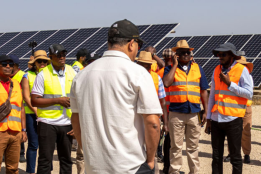To help developing countries transform their energy systems and meet their growing energy needs, the CIF and its partners offer a variety of financial solutions that can unlock scaled investment in transformational technologies. A new independent study by Bloomberg New Energy Finance (BNEF) highlights how these tools can be best targeted to maximize private sector investment in rapidly evolving energy markets.
When the CIF was created in 2008, total installed capacity for onshore wind around the world was just 114 GW. At the end of 2023, it was 945 GW. In the same period, solar photovoltaics (PV) capacity jumped from 14.7 to 1,412 GW – representing nearly a hundredfold increase.
Once considered novel, risky, and expensive, both solar PV and wind are now considered mature technologies in many markets – and are even the cheapest sources of electricity in many countries.
Improved and lower-cost batteries and other technologies are making it easier to integrate energy at scale into the grid. And green hydrogen is emerging as an alternative to fossil fuels in heavy industry and other sectors.
Yet, despite the many benefits of renewable energy for sustainable economic growth, only a small fraction of the technical potential has been developed, and many lower-income countries lag.
So how can the CIF, its partners, and other development institutions make the biggest impact with their resources?
A new independent study, by BNEF sets out priorities for action around three goals:
- Accelerating the deployment of mature technologies,
- Supporting the deployment of less mature technologies, and
- Supporting the integration of intermittent energy sources to provide alternative baseload generation.
By modelling the hypothetical effects of CIF’s concessional finance on bringing down the costs for solar PV, onshore wind and battery storage technologies in select case countries, the study identifies a need to distinguish between markets in which clean technologies are already commercially viable, and those where concessional debt is still needed to reduce upfront costs and lower investment risks. Countries in both groups may still need funding for technical assistance to create enabling environments for investment, including supportive policies and regulatory reforms.
The study recommends a few ways to target resources more effectively:
1. Identify countries in which the markets for PV and/or onshore wind are now mature, meaning the technology costs and risks are low enough for scaled private sector investment.
2. Prioritize funding for technical assistance in countries with weak enabling environments to attract renewable energy investment.
3. Fund technical assistance to help countries design markets that can integrate a growing share of intermittent renewable energy while maintaining system stability.
4. The CIF and its partners also have a key role to play in helping to address country-, market-, and currency-related risks that continue to hinder investment.
The study finds that the use of integrated financial solutions that combine concessional debt and equity, equity guarantees, and capex subsidies can be the most effective approach to help reduce financing costs and therefore accelerate the deployment of less mature technologies such as battery storage.
Despite its potential for wide application, including in heavy industries, investment in green hydrogen has been slow to take off, largely because the technology is still relatively new and thus costly, and enabling environments are not yet in place. CIF and partners can play a transformative role by supporting governments with technical assistance funding to help in the design of national hydrogen strategies, regulatory frameworks, demand-side policies, and infrastructure roadmaps.
A third set of recommendations focuses on how concessional finance can be best targeted to help countries deliver new sources of baseload energy generation. The study explores a range of financial tools that can help bring down the cost of financing pioneering, reliable and sustainable energy systems co-located with storage.




